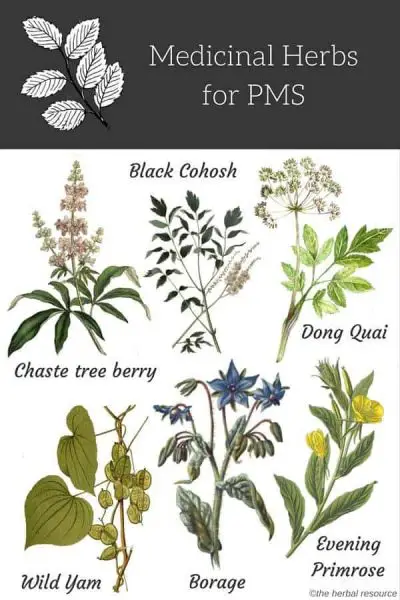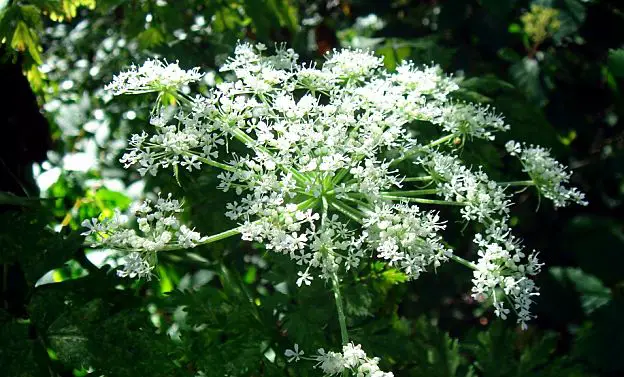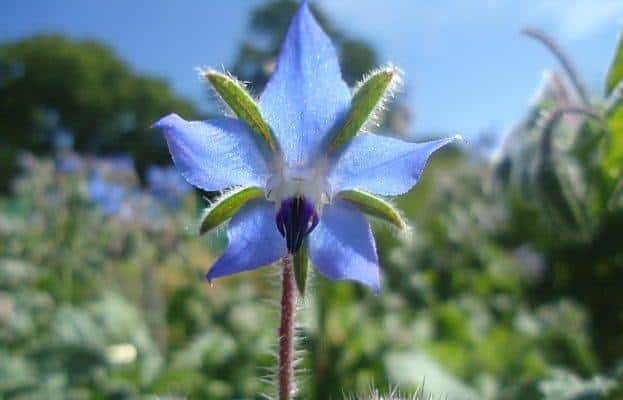The use of medicinal herbs can be helpful in relieving many of the symptoms associated with PMS
These medicinal herbs for PMS should have the ability to naturally balance hormonal fluctuations in the woman’s monthly cycle.
Most women at some time during their reproductive life will experience the discomfort associated with premenstrual syndrome.
The medical term, premenstrual syndrome, incorporates a variety of symptoms that usually start to occur two weeks before a woman has her monthly period.
Medicinal herbs for PMS essentially act as hormonal balancers.
In addition to using herbs, diet, and nutrition can help ease the severity of PMS.
Vitamin B6 (Pyridoxine) and Vitamin E combined with a quality multi-vitamin that includes magnesium and chromium may help combat fluctuations in blood sugar.
Essential fatty acids can also be added to the diet by using flaxseed (linseed) oil and by taking starflower oil or evening primrose oil capsules.
A good natural treatment for PMS remedy will consist of vitamins, herbs, and minerals that act together to assist with relieving the symptoms associated with premenstrual syndrome.

Medicinal Herbs for PMS Relief
Chaste tree berry
Chaste tree berry (Vitex agnus castus) is widely considered the most important herb in treating PMS.
Since the days of Hippocrates, 2500 years ago, chaste tree has been used to treat a variety of gynecological complaints in women.
Many herbalists today prescribe the chaste tree to relieve symptoms of PMS, specifically painful breasts prior to menses, edema, depression, diarrhea/constipation and headache associated with PMS.
Studies into this plant’s safety and effectiveness have been numerous in recent years, where chaste tree has shown itself again and again to be a safe, effective treatment for PMS.
One recent German study of over 1600 women experiencing PMS, showed 93% had a reduction or cessation of their PMS symptoms, after taking chaste tree.
The principal action of chaste tree is in regulating ovarian hormones by stimulating the pituitary gland. (1)(2)
Black Cohosh
Black Cohosh (Cimicifuga racemosa) is well documented and is becoming increasingly popular as an herbal treatment for PMS when combined with chaste tree (Vitex agnus castus) to act as a hormonal balancer.
The antispasmodic action of black cohosh is helpful in relieving menstrual cramps (dysmenorrhoea). (3)

Dong Quai
For centuries Dong Quai (Angelica sinensis) has been prescribed for hormonal imbalance. In traditional Chinese medicine(TCM), dong quai is called “Women’s Ginseng”, and is considered to be an overall tonic for women’s sexual health.
In relieving symptoms of PMS, dong quai is often helpful in relieving premenstrual migraine. (4)
Wild Yam
The phytosterols found in wild yam (Dioscorea villosa) also help precursors to estrogen and progesterone in the body.
It is thought that some of the symptoms of PMS are associated with a dominance of estrogen in the second half (luteal phase) of the menstrual cycle.
In treating PMS, the progesterone in wild yam is helpful in addressing this imbalance. (5)
St John’s Wort
The small yellow flowers of St John’s Wort (Hypericum perforatum) reflect the mild action of this antidepressant.
St John’s wort is also a gentle sedative that assists with moderate depression, anxiety, and insomnia.
The St John’s wort’s flowers contain hypericin, and hyperforin both considered to be vital components in this herbs mood lifting action. (6)
Evening Primrose
Evening primrose oil (EPO) (Oenothera biennis) is high in an essential fatty acid, called gamma linoleic acid (GLA).
Women who are low in GLA are known to be more sensitive to the hormone, prolactin, which is believed to cause breast tenderness (mastalgia).
Supplementing with EPO is effective in reducing the symptoms of PMS, however, it is advised that symptoms may reduce gradually for some women over two to three cycles. (7)

Borage/Star Flower Oil
Starflower or borage oil (Borago officinalis) is not as well-known as evening primrose, but it has significantly higher concentrations of gamma linoleic acid (GLA).
White Peony
White peony (Paeonia lactiflora), also known as Chinese peony has been part of traditional Chinese medicine for a long time.
It is one of the components in a Chinese medicinal formula known as “Si Mu Tang”, which also contains Rehmannia, Chinese angelica (dong quai), and Ligusticum striatum.
The herbal formula is mostly used for tonifying the blood and regulating menstruation.
The herb is regarded to be useful for cramps, irregular bleeding, brain fog, and hormone-induced headaches. (8)
Other Natural Herbs That Have Been Used for PMS Relief
- Buchu – (Agathosma betulina)
- Anise – (Pimpinella anisum)
- Hyssop – (Hyssopus officinalis)
- Flaxseed – (Linum usitatissimum)
- Pasque Flower – (Pulsatilla vulgaris)
Supporting References
- Zamani, Mehrangiz & Neghab, Nosrat & Torabian, Saadat. (2012). Therapeutic Effect of Vitex Agnus Castus in Patients with Premenstrual Syndrome. Acta medica Iranica. 50. 101-6.
- Cerqueira, Raphael & N. Frey, Benicio & Leclerc, Emilie & Brietzke, Elisa. (2017). Vitex agnus castus for premenstrual syndrome and premenstrual dysphoric disorder: a systematic review. Archives of Women’s Mental Health. 20. 10.1007/s00737-017-0791-0.
- Rhyu, M. R., Lu, J., Webster, D. E., Fabricant, D. S., Farnsworth, N. R., & Wang, Z. J. (2006). Black cohosh (Actaea racemosa, Cimicifuga racemosa) behaves as a mixed competitive ligand and partial agonist at the human mu opiate receptor. Journal of agricultural and food chemistry, 54(26), 9852–9857. doi:10.1021/jf062808u.
- Assessment report on Angelica sinensis (Oliv.) Diels, radix. European Medicines Agency. Committee on Herbal Medicinal Products (HMPC). 9 July 2013 EMA/HMPC/614586/2012.
- Komesaroff, Paul & V. S. Black, C & Cable, V & Sudhir, K. (2001). Effects of wild yam extract on menopausal symptoms, lipids and sex hormones in healthy menopausal women. Climacteric: the journal of the International Menopause Society. 4. 144-50. 10.1080/713605087.
- Stevinson, C & Ernst, Edzard. (2000). A pilot study of Hypericum perforatum for the treatment of premenstrual syndrome. BJOG : an international journal of obstetrics and gynecology. 107. 870-6.
- Kashani, L., Saedi, N., & Akhondzadeh, S. (2010). Femicomfort in the treatment of premenstrual syndromes: a double-blind, randomized and placebo-controlled trial. Iranian Journal of Psychiatry, 5(2), 47–50.
- Chen, H. Y., Huang, B. S., Lin, Y. H., Su, I. H., Yang, S. H., Chen, J. L., … Chen, Y. C. (2014). Identifying Chinese herbal medicine for premenstrual syndrome: implications from a nationwide database. BMC complementary and alternative medicine, 14, 206. doi:10.1186/1472-6882-14-206
Leave a Reply